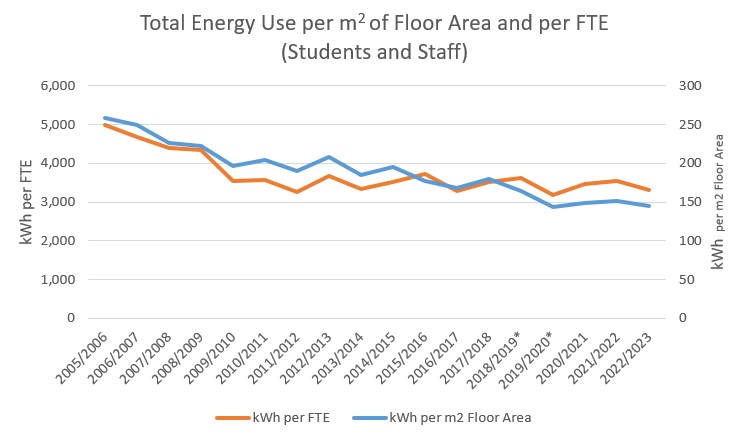Energy Management
Energy Use at Bangor
With more than 100 buildings across Bangor, Menai Bridge & Wrexham, Bangor University uses a significant amount of energy every year for day-to-day operations including heating, lighting and running equipment.
During the 2022/23 academic year, Bangor University used around 32.4 million kWh (32.4 GWh) of energy. That’s equivalent to the annual energy use of around 2,288 medium UK homes(1). Most of this energy (17.96 million kWh, approximately 55.3%) was in the form of natural gas for heating buildings and providing hot water. Carbon emissions associated with the University’s use of natural gas totalled 3,286 tonnes CO2e* for 2022/23.
Electricity for lighting, computers and other equipment was the next most significant form of energy use at the University (13.9 million kWh approximately 42.9%). The other 1.8% of energy use was in the form of LPG and Heating Oil, to provide heating to our properties that are not connected to mains gas.

* Including corrected FTE data for 2018/19 and 2019/20
For more information on the University’s environmental performance, all our Annual Environment Reports can be found here.
Energy and Carbon Emissions
As a University, we understand that our use of fossil-fuel derived energy is contributing to global climate change. In 2019, the University declared a Climate Emergency and in 2020 approved a target to reach net zero carbon scope 1 and 2 by 2030.
Since 2005, the University has been working to reduce energy use and associated carbon emissions through our Environmental Management System. Between 2005 and 2023, we have reduced our total energy use per m2 floor area by 43.9%.
Energy Efficiency
Between 2018 and 2019, Bangor University invested £2.5 million in energy efficiency improvements as part of the Welsh Government’s ReFit Cymru scheme. In total, the scheme is projected to reduce the University’s energy consumption by around 12%. For more information, see the ReFit Case Study page.
Whilst we are taking steps to make the University more energy efficient, and to reduce the carbon emissions associated with our energy use, it is still important that every member of the University does their bit to help us meet our energy and carbon reduction goals.
- Many rooms have sensors to turn lights on and off, but some rooms don’t. When you leave a room, check if the lights need to be turned off and don’t leave lights on in empty rooms
- Turn your computer off when not in use, especially over weekends and holiday periods
- If you can, turn off any equipment when it isn’t in use. Always check with the owner/user of any equipment before switching it off though, as it might be part of an experiment or other important procedure
- Don’t leaver chargers plugged in when not in use
- If the temperature in your space is too high or too low, report it to campusservices@bangor.ac.uk
- Consider the energy efficiency ratings of new equipment before purchasing
*CO2e: Carbon Dioxide Equivalent. Click here for a definition.
(1) - Based on Ofgem's estimate useage of 2,700 kWh of electricity and 11,500 kWh of gas in a year (at 06/02/24)
